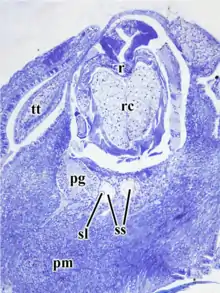Statocyst
The statocyst is a balance sensory receptor present in some aquatic invertebrates, including molluscs,[1] bivalves,[2] cnidarians,[3] ctenophorans,[4] echinoderms,[5] cephalopods,[6] and crustaceans.[7] A similar structure is also found in Xenoturbella.[8] The statocyst consists of a sac-like structure containing a mineralised mass (statolith) and numerous innervated sensory hairs (setae). The statolith's inertia causes it to push against the setae when the animal accelerates. Deflection of setae by the statolith in response to gravity activates neurons, providing feedback to the animal on change in orientation and allowing balance to be maintained.


In other words, the statolith shifts as the animal moves. Any movement large enough to throw the organism off balance causes the statolith to brush against tiny bristles which in turn send a message to the brain to correct its balance.
Hearing
In cephalopods like squids, statocysts provide a cochlea-like mechanism to hear.[9][10] As a result, the longfin inshore squid for instance can hear low-frequency sounds between 30 and 500 Hz when the water temperature is above 8 ºC.[11]
See also
- Accelerometer
- Inertial guidance
- Müllerian vesicle, similar structure in loxodid ciliates
- Otolith, an equivalent structure in vertebrates.
- Statocyte, a similar structure in plants
- Sensory organs of gastropods
References
- Levi, R.; Varona, P.; Arshavsky, Y. I.; Rabinovich, M. I.; Selverston, A. I. (2004). "Dual Sensory-Motor Function for a Molluskan Statocyst Network". Journal of Neurophysiology. 91 (1): 336–345. doi:10.1152/jn.00753.2003.
- Morton, B. (2009). "Statocyst structure in the Anomalodesmata (Bivalvia)". Journal of Zoology. 206: 23–34. doi:10.1111/j.1469-7998.1985.tb05633.x.
- Spangenberg, D. B. (1986). "Statolith formation in Cnidaria: effects of cadmium on Aurelia statoliths". Scanning Electron Microscopy (4): 1609–1618. PMID 11539690.
- Lowe, B. (1997). "The role of Ca2+ in deflection-induced excitation of motile, mechanoresponsive balancer cilia in the ctenophore statocyst". Journal of Experimental Biology. 200: 1593–1606. PMID 9202448.
- Ehlers, U. (1997). "Ultrastructure of the statocysts in the apodous sea cucumber Leptosynapta inhaerens (Holothuroidea, Echinodermata)". Acta Zoologica. 78: 61–68. doi:10.1111/j.1463-6395.1997.tb01127.x.
- Clarke, M. R. (2009). "The cephalopod statolithan—introduction to its form". Journal of the Marine Biological Association of the United Kingdom. 58 (3): 701–712. doi:10.1017/S0025315400041345.
- Cohen, M. J. (1960). "The response patterns of single receptors in the crustacean statocyst". Proceedings of the Royal Society B: Biological Sciences. 152 (946): 30–49. doi:10.1098/rspb.1960.0020. PMID 13849418.
- Israelsson, O. (2007). "Ultrastructural aspects of the 'statocyst' of Xenoturbella (Deuterostomia) cast doubt on its function as a georeceptor". Tissue and Cell. 39 (3): 171–177. doi:10.1016/j.tice.2007.03.002. PMID 17434196.
- http://www.whoi.edu/oceanus/feature/scientists-find-that-squid-can-detect-sounds
- https://www.livescience.com/11707-squid-hear-itos-motion-ocean.html
- https://phys.org/news/2011-02-squid-shown.html



